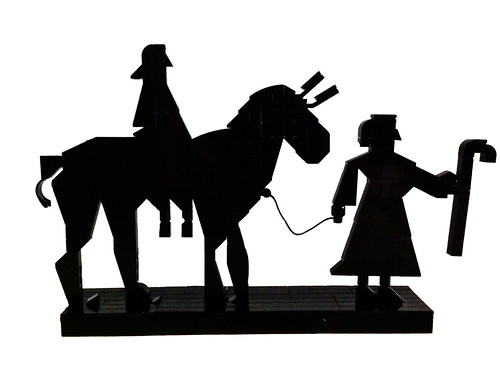
| Please visit the other 'Bricks' blogs: |
|
Wednesday, December 25, 2013
Monday, December 23, 2013
Book review: Big Unofficial LEGO Builder's Book
The Big Unofficial LEGO Builder's Book by Joachim klang and Oliver Albrecht, 2012, HEEL Verlag GmbH
Please note that I'm posting this same review across all my blogs, but I'm appending some blog-specific information at the end of each one.

Okay, this one is a year old, but I just got it from the library and figured I'd add to my series of reviews. Oliver Albrecht (aka *Olly*) and Joe Klang (aka -derjoe-) built The Big Unofficial LEGO Builder's Book, subtitled 'Build your own city'. As the name implies, this is all about building in the city theme. Really, though, it is mostly about vehicles, so a more accurate subtitle would have been something like 'Driving around the city'.

The book opens with a few pages of text, providing some definitions and acronyms that AFOLs use, urls to a few important community websites (of course it's always problematic which ones to choose), and a short tutorial on SNOT building. One thing really bothered me. On page 14 when they are discussing making balls, they write "A variety of solutions circulate in the LEGO forums around the world; here is ours:", and then they give exactly the instructions for the Lowell sphere. I'm not saying that there is ownership of LEGO building techniques, and you need to give credit when you build anything, since almost every technique has been done before. But don't specifically say "Here is my design", and then give someone else's design.

That quibble aside, the book quickly moves into it's main focus, directions to build city-themed MOCs, mostly cars and trucks. The first half of the book is devoted to microscale. There are 22 cars and trucks, all built at 2-wide, with 5-plate-high people. I like that they do wheels a few different ways, which lends some variety to your microscale world. They also show how you can take the same basic car design, and by varying up the colors and switching out a few parts you can get a lot of different vehicles. They also include directions for a couple of buildings, a tree, a helicopter and a plane. The designs are all well done. They are fairly simple, since micro cars are necessarily only a small number of parts, probably appropriate for intermediate builders. The instructions are very clear in LDRAW and in full color, and include parts lists. Interspersed with the directions, they have photographs of a large microscale city layout, incorporating all of the different designs in the book. The layout is great, and I would have loved to see even more of this.

In the last ~40% of the book they focus on minifig scale. A cab, a Ferrari, a convertable, a truck, and a helicopter are all built at a six-wide scale. Again, the instructions are done in LDRAW, full color, with parts lists. These models are more for intermediate to advanced builders, and the results are really good (especially the truck). There are a few photos of the completed models, but mostly just the vehicles on simple bases (there is one with a house) rather than set into a larger layout. While I liked the minifig scale vehicles, I really thought these should have been in a separate book, and left this book just at microscale.
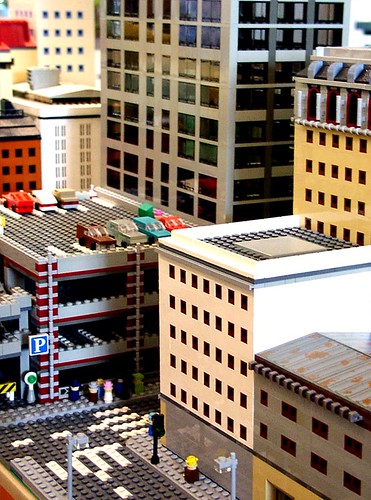
I thought this book turned out really well. The models were great, and now I want to go build more micro city MOCs. I note that the same builders have been busy, with the previously noted Joe's Garage: Build your own LEGO Vehicles by Klang, and Build your own Galaxy along with Lutz Uhlmann and Tim Bischoff.
Blog-specific content - There is none.
Please note that I'm posting this same review across all my blogs, but I'm appending some blog-specific information at the end of each one.

Okay, this one is a year old, but I just got it from the library and figured I'd add to my series of reviews. Oliver Albrecht (aka *Olly*) and Joe Klang (aka -derjoe-) built The Big Unofficial LEGO Builder's Book, subtitled 'Build your own city'. As the name implies, this is all about building in the city theme. Really, though, it is mostly about vehicles, so a more accurate subtitle would have been something like 'Driving around the city'.

The book opens with a few pages of text, providing some definitions and acronyms that AFOLs use, urls to a few important community websites (of course it's always problematic which ones to choose), and a short tutorial on SNOT building. One thing really bothered me. On page 14 when they are discussing making balls, they write "A variety of solutions circulate in the LEGO forums around the world; here is ours:", and then they give exactly the instructions for the Lowell sphere. I'm not saying that there is ownership of LEGO building techniques, and you need to give credit when you build anything, since almost every technique has been done before. But don't specifically say "Here is my design", and then give someone else's design.

That quibble aside, the book quickly moves into it's main focus, directions to build city-themed MOCs, mostly cars and trucks. The first half of the book is devoted to microscale. There are 22 cars and trucks, all built at 2-wide, with 5-plate-high people. I like that they do wheels a few different ways, which lends some variety to your microscale world. They also show how you can take the same basic car design, and by varying up the colors and switching out a few parts you can get a lot of different vehicles. They also include directions for a couple of buildings, a tree, a helicopter and a plane. The designs are all well done. They are fairly simple, since micro cars are necessarily only a small number of parts, probably appropriate for intermediate builders. The instructions are very clear in LDRAW and in full color, and include parts lists. Interspersed with the directions, they have photographs of a large microscale city layout, incorporating all of the different designs in the book. The layout is great, and I would have loved to see even more of this.

In the last ~40% of the book they focus on minifig scale. A cab, a Ferrari, a convertable, a truck, and a helicopter are all built at a six-wide scale. Again, the instructions are done in LDRAW, full color, with parts lists. These models are more for intermediate to advanced builders, and the results are really good (especially the truck). There are a few photos of the completed models, but mostly just the vehicles on simple bases (there is one with a house) rather than set into a larger layout. While I liked the minifig scale vehicles, I really thought these should have been in a separate book, and left this book just at microscale.

I thought this book turned out really well. The models were great, and now I want to go build more micro city MOCs. I note that the same builders have been busy, with the previously noted Joe's Garage: Build your own LEGO Vehicles by Klang, and Build your own Galaxy along with Lutz Uhlmann and Tim Bischoff.
Blog-specific content - There is none.
Thursday, December 19, 2013
Book review: Extreme Bricks
Extreme Bricks by Sarah Herman, 2013, Skyhorse Publishing
Please note that I'm posting this same review across all my blogs, but I'm appending some blog-specific information at the end of each one.

Next up in my series of LEGO book reviews is Extreme Bricks. Last year, when I reviewed A Million Little Bricks: The Unofficial Illustrated History of the LEGO Phenomenon by Sarah Herman, one of my main critiques was that she spent the bulk of the book on a recap of the corporate history of the LEGO Group, and only a handful of pages at the end on the AFOL community. Well, she's come back to the subject to correct this problem. Or perhaps all along she planned on writing two books, one on the company and one on the builders. This book is about MOCs, big ones. The subtitle is "Spectacular, Record-Breaking, and Astounding LEGO Projects from Around the World." That gives you an idea of her focus. This book is all about really big creations.

The book still starts in the corporate world, but I found it more interesting than her previous book. Here she focuses in the first couple of chapters on the large models that LEGO built for in-store promotions and at the first Legoland park, including an extended treatment of the large Sitting Bull by Bjorn Richter. She also looks at things like the James May LEGO house, the giant X-Wing that was unveiled in Times Square, and sculptures comissioned by LEGO. But she quickly moves into things that are probably more interesting to community members, MOCs built by the true fans.
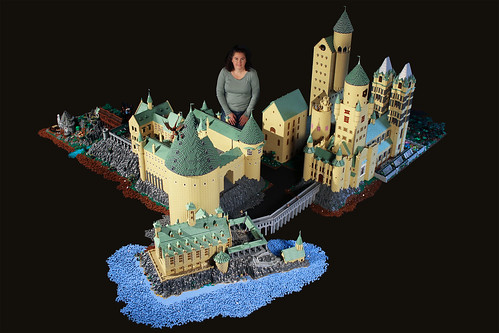
If you read the LEGO blogs, these are mostly things you've seen, like Alice Finch's Hogwarts, the OneLUG March of the Ents, Ed Diment's aircraft carrier, and the like. Names like Sawaya, Kenney, McIntyre, McNaught and other professional builders are all over this book. I really like that Herman interviewed all of the builders, giving backgrounds to the models, building tips, and links to find more of their work online. I have to admit I was a little off-put by the bigness of it all. This is absolutely no knock on the specific MOCs or builders featured, I realize that there are particular challenges and skills involved in building big, but at times it feels like what matters to this book is not that the models are excellent, but that they are really large. It's been pointed out before that when visitors to the public exhibition at fan conventions get to vote on their favorite model, they inevitably choose the largest.

Herman does pretty well at highlighting the community. Many books by people from outside the community, and even from some on the inside, mention Lugnet and the Brothers-Brick and stop there, but Herman does an admirable job of mentioning a variety of online communities, photo-sharing sites, and cons. It's still not the definitive history of the AFOL community that I'd love to see someday, showing the rise and fall of different forums, fests, fan themes, etc, but it's a start.

I do have a couple of critiques. The text reads like it comes from the outside. This does not feel the same as those books written by members of the AFOL community, nor does it feel like the writing of Jonathan Bender, a reporter who started out examining this crazy phenomenon and came to truly love it. It feels like the work of an outsider looking in - a reporter who is certainly impressed by these creations and their builders, but not someone who really knows it in her heart. My other critique is the pictures. This book is smaller than many of the LEGO books I've read - the pages are about 9 inches tall - and the bulk of the images are about a quarter of a page. A book devoted to really large creations should have large pictures, so you can appreciate the actual details of the MOCs rather than just their bigness. This book would have been better served by being at the same size as Brick Shakespeare, another output from the same publishing house, with at least one picture of each MOC that filled the whole page.

Blog-specific content - There's nothing here, which was surprising. Wouldn't it be natural for something like Jürgen Bramigk's Kölner Dom to be in this book? I think she mentioned large cathedrals as one of the sorts of big MOCs that AFOLs build, but I can't find the line in skimming back through the book.
Please note that I'm posting this same review across all my blogs, but I'm appending some blog-specific information at the end of each one.

Next up in my series of LEGO book reviews is Extreme Bricks. Last year, when I reviewed A Million Little Bricks: The Unofficial Illustrated History of the LEGO Phenomenon by Sarah Herman, one of my main critiques was that she spent the bulk of the book on a recap of the corporate history of the LEGO Group, and only a handful of pages at the end on the AFOL community. Well, she's come back to the subject to correct this problem. Or perhaps all along she planned on writing two books, one on the company and one on the builders. This book is about MOCs, big ones. The subtitle is "Spectacular, Record-Breaking, and Astounding LEGO Projects from Around the World." That gives you an idea of her focus. This book is all about really big creations.

The book still starts in the corporate world, but I found it more interesting than her previous book. Here she focuses in the first couple of chapters on the large models that LEGO built for in-store promotions and at the first Legoland park, including an extended treatment of the large Sitting Bull by Bjorn Richter. She also looks at things like the James May LEGO house, the giant X-Wing that was unveiled in Times Square, and sculptures comissioned by LEGO. But she quickly moves into things that are probably more interesting to community members, MOCs built by the true fans.

If you read the LEGO blogs, these are mostly things you've seen, like Alice Finch's Hogwarts, the OneLUG March of the Ents, Ed Diment's aircraft carrier, and the like. Names like Sawaya, Kenney, McIntyre, McNaught and other professional builders are all over this book. I really like that Herman interviewed all of the builders, giving backgrounds to the models, building tips, and links to find more of their work online. I have to admit I was a little off-put by the bigness of it all. This is absolutely no knock on the specific MOCs or builders featured, I realize that there are particular challenges and skills involved in building big, but at times it feels like what matters to this book is not that the models are excellent, but that they are really large. It's been pointed out before that when visitors to the public exhibition at fan conventions get to vote on their favorite model, they inevitably choose the largest.

Herman does pretty well at highlighting the community. Many books by people from outside the community, and even from some on the inside, mention Lugnet and the Brothers-Brick and stop there, but Herman does an admirable job of mentioning a variety of online communities, photo-sharing sites, and cons. It's still not the definitive history of the AFOL community that I'd love to see someday, showing the rise and fall of different forums, fests, fan themes, etc, but it's a start.

I do have a couple of critiques. The text reads like it comes from the outside. This does not feel the same as those books written by members of the AFOL community, nor does it feel like the writing of Jonathan Bender, a reporter who started out examining this crazy phenomenon and came to truly love it. It feels like the work of an outsider looking in - a reporter who is certainly impressed by these creations and their builders, but not someone who really knows it in her heart. My other critique is the pictures. This book is smaller than many of the LEGO books I've read - the pages are about 9 inches tall - and the bulk of the images are about a quarter of a page. A book devoted to really large creations should have large pictures, so you can appreciate the actual details of the MOCs rather than just their bigness. This book would have been better served by being at the same size as Brick Shakespeare, another output from the same publishing house, with at least one picture of each MOC that filled the whole page.

Blog-specific content - There's nothing here, which was surprising. Wouldn't it be natural for something like Jürgen Bramigk's Kölner Dom to be in this book? I think she mentioned large cathedrals as one of the sorts of big MOCs that AFOLs build, but I can't find the line in skimming back through the book.
Wednesday, December 18, 2013
Saturday, December 14, 2013
Book review: Brick Shakespeare: The Tragedies
Brick Shakespeare: The Tragedies by John McCann, Monica Sweeney, and Becky Thomas, 2013, Skyhorse Publishing
Please note that I'm posting this same review across all my blogs, but I'm appending some blog-specific information at the end of each one.

Next up in my survey of LEGO books is Brick Shakespeare: The Tragedies. John McCann is credited with building and photographing the LEGO creations, while Monica Sweeney and Becky Thomas abridged and edited the plays' texts and wrote introductions and synopses. As the name suggests, this is basically a LEGO-illustrated version of Hamlet, Macbeth, Romeo and Juliet, and Julius Ceasar (listed as the four most well known tragedies, personally I would have listed Lear before Ceasar, but okay). The text is original shakespeare, though they say it is lightly abridged (I haven't gone back and compared, and it's been ages since I've read the plays, so I can't say how much they were abridged). If you are familiar with the two large Brick Bible volumes, you can tell that some of the same people at Skyhorse were involved in putting this together, because the format is largely the same (same size book, about the same number of pages, LEGO pictures in sort of a comic-book layout with text in boxes). Each play starts with a Dramatis Personae showing pictures of the minifigs in each role, and a short description of that play.

I wanted to love this book, and I should have. My first real area of building after I emerged from my dark age was LEGO illustration of stories, and I've even made a handful of Shakespeare scenes before. Unfortunately, I just can't endorse this book. The LEGO scenes themselves, which should be the star (I mean, I already have copies of most of the plays), are really subpar. I help run Classic-Castle, a site dedicated to LEGO Castle building, and so every day I see scene after scene that are significantly better than what is found in the Hamlet, Macbeth, and Romeo and Juliet stories, and a quick check of the Greco-Roman LEGO group on Flickr will show the same for the Julius Ceasar chapter. I'm sorry to be harsh; a few years ago I might have been more positive about this book, but this year I have to set it beside things like Assasination! and LEGO Space, illustrated story books with amazing LEGO building. One suggestion for anyone taking on a project like this: Shakespeare is written for the stage, which means that there will be only a very few settings. That means you only have to build a few different scenes, and then place the figs within them. Therefore, those scenes should be amazing. I really felt like I could have built any of the individual scenes in this book in a single sitting at my LEGO table. Probably the only scene that really impressed me was the balcony scene from Romeo and Juliet, but that was a barely reworked version of set 10223, Kingdoms Joust.

A couple of curious things about this. On Skyhorse's own website, the author is listed as 'Jack Hollan'. In the 'About the Authors' section of the published work, McCann, Sweeney, and Thomas are referred to as the 'Hollan Publishing team', and McCann's LinkedIn page says he works for Hollan Publishing. It turns out the Hollan Publishing is a company that, in their words "are conceptual agents and book packagers who develop compelling non-fiction concepts and work with promotable expert personalities to deliver strong books across a range of categories." Interesting. Another clue that I find is that on the Skyhorse site, and also on the Hollan site, an alternate cover is shown. Interestingly, IMO a couple of the images on the alternate cover look pretty good (the witches at the top and the Lady Macbeth at the bottom). Purely speculation, but my guess is that someone at Hollan came up with the idea, put together a mock-up cover, and shopped it to Skyhorse, and then went and found McCann to build the whole stories. Alternatively, McCann first came up with the idea, got signed by Hollan, and in the process of building the whole stories he reworked all of his photos.

I can't find much about McCann. The 'about the author' section says he's been building with LEGO for twenty years, but I find no evidence that he's involved in the larger AFOL community at all (i.e. no Brickshelf, MOCpage, or Flickr account, also no mention of him on the NELUG site). The aforementioned LinkedIn account says that his current job at Hollan involves "Building Lego sets and taking photos to act out 8 different Shakespeare play and Brothers Grimm Fairy Tales to illustrate 3 different children / young adult books." (see below for the other books). I think this book would have been improved by some interaction with the AFOL community. I'm not trying to be snobbish and say that everything has to conform to the latest popular building techniques, but he doesn't seem to be aware of the high quality scenes you can build out of LEGO, including other peoples' LEGO Shakespeare scenes.

Unfortunately, I have to give this a negative review. I love the idea, but was disappointed by the execution. This is really not for AFOLs; the best audience would be a younger teen who likes LEGO, but needs some hook to get them interested in great literature. If you enjoy this book, you'll be happy to note that Barnes & Noble lists two additional books by the same team. The first is a follow up volume called Brick Shakespeare: The Comedies, which will include A Midsummer Night’s Dream, Much Ado About Nothing, The Taming of the Shrew, and The Tempest, due out in April of 2014. The second is Brick Fairy Tales, which will include "Cinderella, Rapunzel, Snow White and the Seven Dwarfs, Hansel and Gretel, and More", and is due out next May.


Blog-specific content - Of course Shakespeare has some religious themes and some clergy as characters.
Please note that I'm posting this same review across all my blogs, but I'm appending some blog-specific information at the end of each one.

Next up in my survey of LEGO books is Brick Shakespeare: The Tragedies. John McCann is credited with building and photographing the LEGO creations, while Monica Sweeney and Becky Thomas abridged and edited the plays' texts and wrote introductions and synopses. As the name suggests, this is basically a LEGO-illustrated version of Hamlet, Macbeth, Romeo and Juliet, and Julius Ceasar (listed as the four most well known tragedies, personally I would have listed Lear before Ceasar, but okay). The text is original shakespeare, though they say it is lightly abridged (I haven't gone back and compared, and it's been ages since I've read the plays, so I can't say how much they were abridged). If you are familiar with the two large Brick Bible volumes, you can tell that some of the same people at Skyhorse were involved in putting this together, because the format is largely the same (same size book, about the same number of pages, LEGO pictures in sort of a comic-book layout with text in boxes). Each play starts with a Dramatis Personae showing pictures of the minifigs in each role, and a short description of that play.

I wanted to love this book, and I should have. My first real area of building after I emerged from my dark age was LEGO illustration of stories, and I've even made a handful of Shakespeare scenes before. Unfortunately, I just can't endorse this book. The LEGO scenes themselves, which should be the star (I mean, I already have copies of most of the plays), are really subpar. I help run Classic-Castle, a site dedicated to LEGO Castle building, and so every day I see scene after scene that are significantly better than what is found in the Hamlet, Macbeth, and Romeo and Juliet stories, and a quick check of the Greco-Roman LEGO group on Flickr will show the same for the Julius Ceasar chapter. I'm sorry to be harsh; a few years ago I might have been more positive about this book, but this year I have to set it beside things like Assasination! and LEGO Space, illustrated story books with amazing LEGO building. One suggestion for anyone taking on a project like this: Shakespeare is written for the stage, which means that there will be only a very few settings. That means you only have to build a few different scenes, and then place the figs within them. Therefore, those scenes should be amazing. I really felt like I could have built any of the individual scenes in this book in a single sitting at my LEGO table. Probably the only scene that really impressed me was the balcony scene from Romeo and Juliet, but that was a barely reworked version of set 10223, Kingdoms Joust.

A couple of curious things about this. On Skyhorse's own website, the author is listed as 'Jack Hollan'. In the 'About the Authors' section of the published work, McCann, Sweeney, and Thomas are referred to as the 'Hollan Publishing team', and McCann's LinkedIn page says he works for Hollan Publishing. It turns out the Hollan Publishing is a company that, in their words "are conceptual agents and book packagers who develop compelling non-fiction concepts and work with promotable expert personalities to deliver strong books across a range of categories." Interesting. Another clue that I find is that on the Skyhorse site, and also on the Hollan site, an alternate cover is shown. Interestingly, IMO a couple of the images on the alternate cover look pretty good (the witches at the top and the Lady Macbeth at the bottom). Purely speculation, but my guess is that someone at Hollan came up with the idea, put together a mock-up cover, and shopped it to Skyhorse, and then went and found McCann to build the whole stories. Alternatively, McCann first came up with the idea, got signed by Hollan, and in the process of building the whole stories he reworked all of his photos.

I can't find much about McCann. The 'about the author' section says he's been building with LEGO for twenty years, but I find no evidence that he's involved in the larger AFOL community at all (i.e. no Brickshelf, MOCpage, or Flickr account, also no mention of him on the NELUG site). The aforementioned LinkedIn account says that his current job at Hollan involves "Building Lego sets and taking photos to act out 8 different Shakespeare play and Brothers Grimm Fairy Tales to illustrate 3 different children / young adult books." (see below for the other books). I think this book would have been improved by some interaction with the AFOL community. I'm not trying to be snobbish and say that everything has to conform to the latest popular building techniques, but he doesn't seem to be aware of the high quality scenes you can build out of LEGO, including other peoples' LEGO Shakespeare scenes.

Unfortunately, I have to give this a negative review. I love the idea, but was disappointed by the execution. This is really not for AFOLs; the best audience would be a younger teen who likes LEGO, but needs some hook to get them interested in great literature. If you enjoy this book, you'll be happy to note that Barnes & Noble lists two additional books by the same team. The first is a follow up volume called Brick Shakespeare: The Comedies, which will include A Midsummer Night’s Dream, Much Ado About Nothing, The Taming of the Shrew, and The Tempest, due out in April of 2014. The second is Brick Fairy Tales, which will include "Cinderella, Rapunzel, Snow White and the Seven Dwarfs, Hansel and Gretel, and More", and is due out next May.


Blog-specific content - Of course Shakespeare has some religious themes and some clergy as characters.
Friday, December 13, 2013
Book review: LEGO Space: Building the Future
LEGO Space: Building the Future by Peter Reid and Tim Goddard, 2013, No Starch Press
Please note that I'm posting this same review across all my blogs, but I'm appending some blog-specific information at the end of each one.
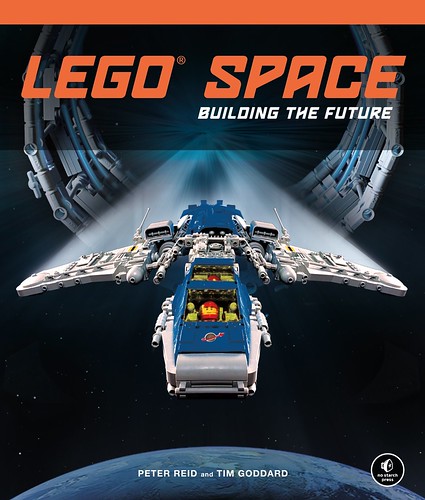
My next review in my journey through the LEGO books that have come out recently is LEGO Space: Building the Future, by Peter Reid (aka Legoloverman) and Tim Goddard (aka Rogue Bantha). This book plays a dual role. On the one hand it is a science fiction story in the genre of future history. On the other it is a showcase for Pete and Tim's amazing models. The book starts out with a few pages of real space history, with some description of Sputnik, the Apollo program, and subsequent unmanned probes, with accompanying LEGO illustrations. I really loved this, and part of me wanted this to go on. I'd really love for these guys, or some other builder like Stephen Pakbaz, Dave Shaddix, or one of the other great builders of 'real space' would do a book dedicated to the actual space program.

That said, I'm not going to fault this book for failing to be something they never intended. LEGO Space quickly jumps ahead, skipping through the centuries of space colonization, and ultimately landing in a more detailed story set in the 26th century, which takes up 90% of the book. The story itself is good but not great. There was some good development, but I was left at the end wanting a little more. The plot surrounds the first contact between human space colonists and a sinister force of aliens. I read the whole thing in a sitting, so it moved along at a good pace, but it's not a story I would go back to again and again.
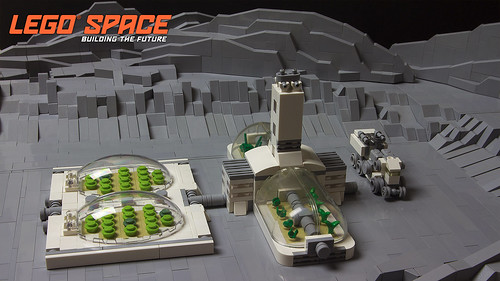
However, I didn't get this book for the story, and so I don't want that to taint my review. It is the LEGO that is the real draw here. Pete and Tim have created a whole series of spaceships, bases, robots and aliens, and woven them together in a visually stunning landscape. The models come in four distinct color schemes that fit together like the sub-themes of Space that LEGO came out with in years past. Both fig-scale and microscale models fit in, and they seem to mesh really well, like the microscale MOCs are truly just smaller images of the fig scale. The book includes sets of instructions (intermediate to advanced level) for many of the smaller MOCs (mostly the microscale ships and also the robots), so you can build your own micro fleet.

AFOLs will certainly recognize Pete and Tim's building styles, and even a few MOCs that they've shown before (sometimes reworked for this book). Of course we all know Pete's amazing Exo-Suit, that has been chosen as an upcoming Cuusoo set. That set, when it comes out, would be perfectly paired with this book as a great gift for the LEGO fan in your life, or just for yourself. Many (all?) of the characters are based on AFOLs, and the world that is colonized was originally a Brickish Association display a couple of years ago. Many of the models reflect Classic Space color schemes, and even reinterpret specific official sets, so old-time space builders will find much to love. There's also a variant on the popular Vic Viper meme. So in all this is a very community-focused book, though not in any way that would leave non-community members scratching their heads.
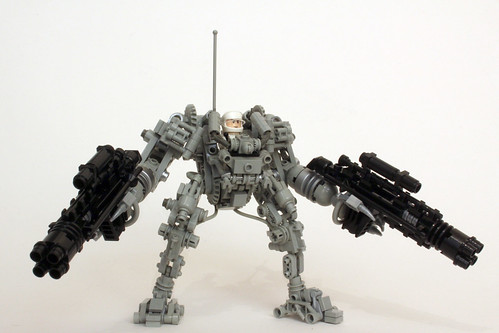
All in all, this is one of my favorite LEGO books of the year. The audience is pretty much anyone who like space at any level, from a young kid up to an advanced AFOL. I'm a little less thrilled by the writing, but I have to qualify that by saying that I pretty much judge future history by Clarke, Asimov, etc, so I set a pretty high bar for my science fiction reading.
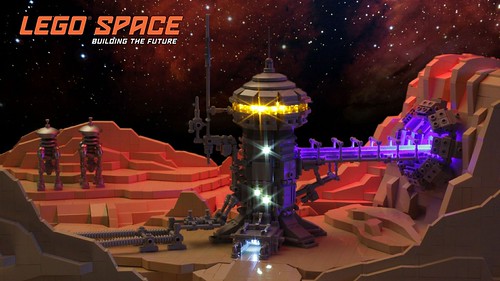
Blog-specific content - There is none.
Please note that I'm posting this same review across all my blogs, but I'm appending some blog-specific information at the end of each one.

My next review in my journey through the LEGO books that have come out recently is LEGO Space: Building the Future, by Peter Reid (aka Legoloverman) and Tim Goddard (aka Rogue Bantha). This book plays a dual role. On the one hand it is a science fiction story in the genre of future history. On the other it is a showcase for Pete and Tim's amazing models. The book starts out with a few pages of real space history, with some description of Sputnik, the Apollo program, and subsequent unmanned probes, with accompanying LEGO illustrations. I really loved this, and part of me wanted this to go on. I'd really love for these guys, or some other builder like Stephen Pakbaz, Dave Shaddix, or one of the other great builders of 'real space' would do a book dedicated to the actual space program.

That said, I'm not going to fault this book for failing to be something they never intended. LEGO Space quickly jumps ahead, skipping through the centuries of space colonization, and ultimately landing in a more detailed story set in the 26th century, which takes up 90% of the book. The story itself is good but not great. There was some good development, but I was left at the end wanting a little more. The plot surrounds the first contact between human space colonists and a sinister force of aliens. I read the whole thing in a sitting, so it moved along at a good pace, but it's not a story I would go back to again and again.

However, I didn't get this book for the story, and so I don't want that to taint my review. It is the LEGO that is the real draw here. Pete and Tim have created a whole series of spaceships, bases, robots and aliens, and woven them together in a visually stunning landscape. The models come in four distinct color schemes that fit together like the sub-themes of Space that LEGO came out with in years past. Both fig-scale and microscale models fit in, and they seem to mesh really well, like the microscale MOCs are truly just smaller images of the fig scale. The book includes sets of instructions (intermediate to advanced level) for many of the smaller MOCs (mostly the microscale ships and also the robots), so you can build your own micro fleet.

AFOLs will certainly recognize Pete and Tim's building styles, and even a few MOCs that they've shown before (sometimes reworked for this book). Of course we all know Pete's amazing Exo-Suit, that has been chosen as an upcoming Cuusoo set. That set, when it comes out, would be perfectly paired with this book as a great gift for the LEGO fan in your life, or just for yourself. Many (all?) of the characters are based on AFOLs, and the world that is colonized was originally a Brickish Association display a couple of years ago. Many of the models reflect Classic Space color schemes, and even reinterpret specific official sets, so old-time space builders will find much to love. There's also a variant on the popular Vic Viper meme. So in all this is a very community-focused book, though not in any way that would leave non-community members scratching their heads.

All in all, this is one of my favorite LEGO books of the year. The audience is pretty much anyone who like space at any level, from a young kid up to an advanced AFOL. I'm a little less thrilled by the writing, but I have to qualify that by saying that I pretty much judge future history by Clarke, Asimov, etc, so I set a pretty high bar for my science fiction reading.

Blog-specific content - There is none.
Thursday, December 12, 2013
Once in Royal David's City
Time to turn our attention to Christmas. Michael Shroeder made this wonderful nativity: Once in Royal David's City.


Wednesday, December 11, 2013
Book review - Badass Bricks: Thirty-Five Weapons of Mass Construction
Badass Bricks: Thirty-Five Weapons of Mass Construction by Jake Mackay, 2013, Skyhorse Publishing
Please note that I'm posting this same review across all my blogs, but I'm appending some blog-specific information at the end of each one.
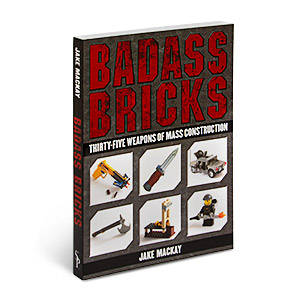
Last year I reviewed a couple of books that provided instructions to build various modern guns out of LEGO. I commented that, at least to my untrained eye, these all kind of looked the same after a bit. I suggested that if someone wanted to do another book along these lines, they should vary it up a bit, perhaps doing more historical weapons, or else weapons from Star Wars or other sci-fi themes. It seems that someone was listening, or at least had the same sort of idea. Jake Mackay has come out with a new book for your consideration, called Badass Bricks: Thirty-Five Weapons of Mass Construction. This book takes a broader view of LEGO-built weapons. Mackay's subject matter is drawn from across history, from a Roman chariot to a nuclear sub. The scale is also varied, from lifesize weapons you can hold in your hand, to a few minifig-scale models, to even a little microscale.
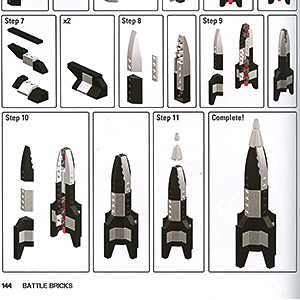
The book is well put together, with clear, full-color instructions. Each model has a very brief description of its historical context and in the back there is a parts list for each. The models themselves range from simple to intermediate. I really like the idea of the book, but in my opinion some of the models come out looking kind of blocky. Also, and I have to state for the record that I have not built all of these, so my intuition may be faulty, but several of the life-size models seem a little fragile. It seems to me that if you build a life-size sword, you want to be able to swing it around a bit without it falling into a million pieces, so I see that as a negative. By far the best model is a fig-scale Humvee, seen below (forgive the image quality, I took a screenshot of the Google Books preview and blew it up a little). There are also some castle-era siege weapons at roughly minifig scale that are pretty nice.
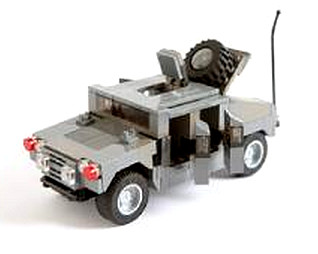
A couple of curious facts: It looks like in some parts of the world this book is being marketed as "Badass Bricks: Forty Weapons of Mass Construction". I wonder why five models seem to have been removed from the US version. From the alternate cover image and the descriptive blurbs for the 40 version, it seems that the missing models are mostly modern guns. I wonder if the publishers felt there was too much overlap with Jack Streat's LEGO Heavy Weapons book. On Mackay's MOCpage (it's older material, with no recent updates), he notes that he admires Streat, and some of his designs on that page were inspired by Streat's work. It's only my speculation, but maybe there was concern that the missing five models came too close to other work. Another confusing note is that the bottom of every other page has the caption "Battle Bricks". I wonder if this was the working title of the book, and at the last moment the publishers changed it to "Badass Bricks".
In sum, this book is okay, but not great. This is a nice addition to my LEGO library, but there are other things out this year that I would rank higher. If you are really into making LEGO-built weapons, you might get this, but on the other hand you could probably just peruse Flickr for ideas. The target audience is probably younger teens who are intermediate builders.
Blog-specific content - There is none.
Please note that I'm posting this same review across all my blogs, but I'm appending some blog-specific information at the end of each one.

Last year I reviewed a couple of books that provided instructions to build various modern guns out of LEGO. I commented that, at least to my untrained eye, these all kind of looked the same after a bit. I suggested that if someone wanted to do another book along these lines, they should vary it up a bit, perhaps doing more historical weapons, or else weapons from Star Wars or other sci-fi themes. It seems that someone was listening, or at least had the same sort of idea. Jake Mackay has come out with a new book for your consideration, called Badass Bricks: Thirty-Five Weapons of Mass Construction. This book takes a broader view of LEGO-built weapons. Mackay's subject matter is drawn from across history, from a Roman chariot to a nuclear sub. The scale is also varied, from lifesize weapons you can hold in your hand, to a few minifig-scale models, to even a little microscale.

The book is well put together, with clear, full-color instructions. Each model has a very brief description of its historical context and in the back there is a parts list for each. The models themselves range from simple to intermediate. I really like the idea of the book, but in my opinion some of the models come out looking kind of blocky. Also, and I have to state for the record that I have not built all of these, so my intuition may be faulty, but several of the life-size models seem a little fragile. It seems to me that if you build a life-size sword, you want to be able to swing it around a bit without it falling into a million pieces, so I see that as a negative. By far the best model is a fig-scale Humvee, seen below (forgive the image quality, I took a screenshot of the Google Books preview and blew it up a little). There are also some castle-era siege weapons at roughly minifig scale that are pretty nice.

A couple of curious facts: It looks like in some parts of the world this book is being marketed as "Badass Bricks: Forty Weapons of Mass Construction". I wonder why five models seem to have been removed from the US version. From the alternate cover image and the descriptive blurbs for the 40 version, it seems that the missing models are mostly modern guns. I wonder if the publishers felt there was too much overlap with Jack Streat's LEGO Heavy Weapons book. On Mackay's MOCpage (it's older material, with no recent updates), he notes that he admires Streat, and some of his designs on that page were inspired by Streat's work. It's only my speculation, but maybe there was concern that the missing five models came too close to other work. Another confusing note is that the bottom of every other page has the caption "Battle Bricks". I wonder if this was the working title of the book, and at the last moment the publishers changed it to "Badass Bricks".
In sum, this book is okay, but not great. This is a nice addition to my LEGO library, but there are other things out this year that I would rank higher. If you are really into making LEGO-built weapons, you might get this, but on the other hand you could probably just peruse Flickr for ideas. The target audience is probably younger teens who are intermediate builders.
Blog-specific content - There is none.
Tuesday, December 10, 2013
Dreidel, dreidel, dreidel, I made it out of some other company's clone blocks
Hanukkah is over, but I've got one more to post before moving on to the season of LEGO-built manger scenes. I didn't post any LEGO-built dreidels this year, because I didn't find any new ones that I didn't post hear last year. The dreidel, of course, is a spinning top that is both used for Hanukkah games and also to remind kids that "A great miracle happened there." Joanna Brichetto, of Bible Belt Balabusta fame, found a clone brand, Binyan Blocks, that sells buildable dreidels, with figures included. Follow the link for Joanna's reviews of these sets.

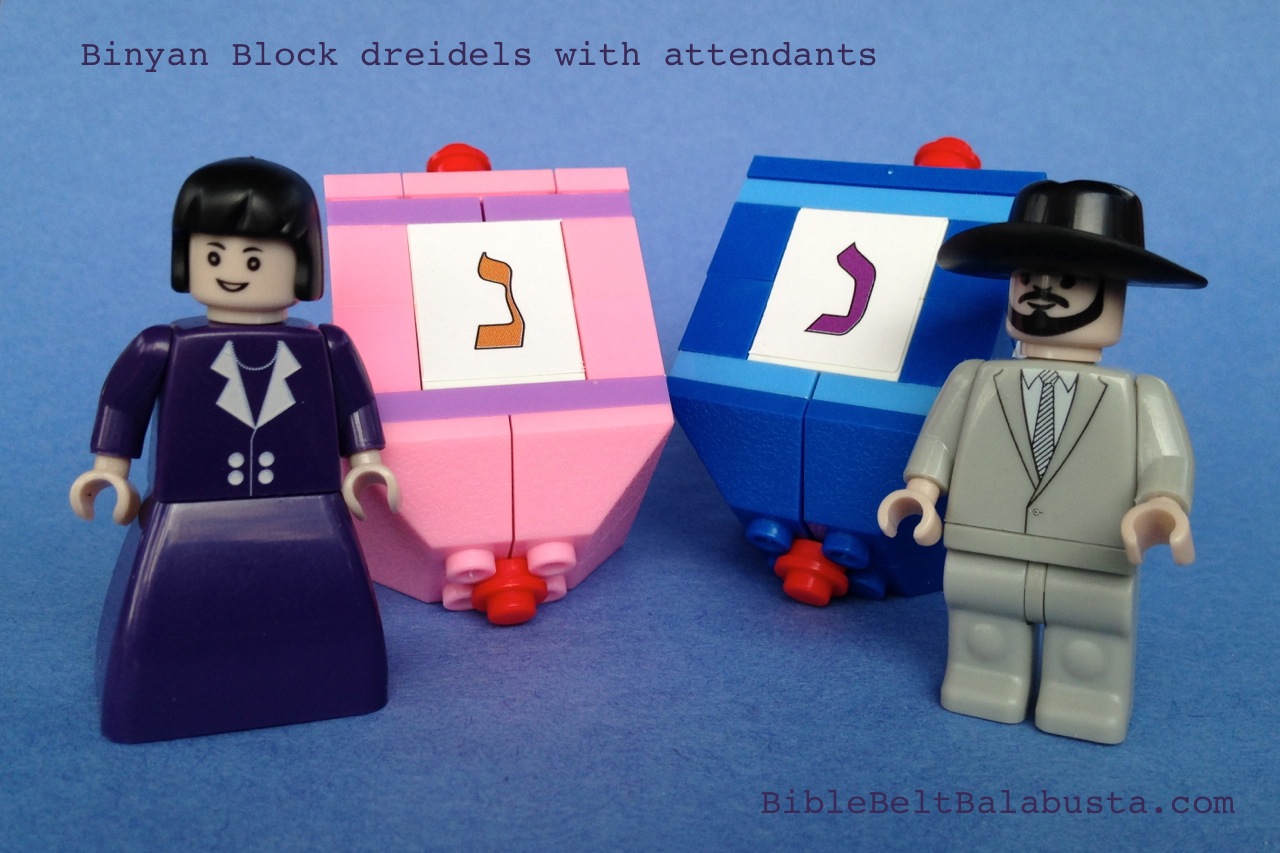


Thursday, December 5, 2013
Public menorahs
Public Menorah lightings have become a common sight in America (and elsewhere?). In recent years it has become fairly common to hear of the construction of giant LEGO Menorahs. I really love this tradition. It uses a medium that really calls out to kids, the LEGO that they love to play with, and it connects them to the joy of their religious tradition. And so you have one last night to drive around your community and see if there are any big LEGO Menorahs out. I hope all of my Jewish readers had a very blessed holiday.
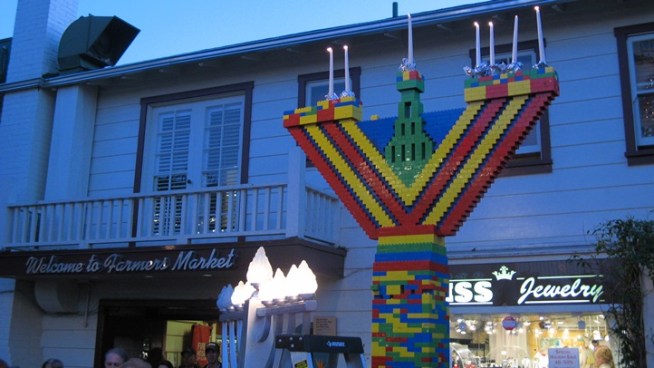

Wednesday, December 4, 2013
Menorah
Yesterday I discussed the meaning behind Hanukkah and went into some history of the Temple Menorah. Here is a traditional Hanukkah Menorah (by Colinreid9). Note that this has nine candles. The one in the middle is called the shamash. It is lit first, and then used to light the other candles, one for each night of Hanukkah. This is done because the Hanukkah candles (or oil lamps) are not supposed to be used for any other purpose except for their light and beauty, proclaiming the miracle of the Temple rededication.


Tuesday, December 3, 2013
Eight crazy nights
I really need to spend a moment recapping the meaning behind Hanukkah, as I haven't done that this year. Back in the second century BCE, Antiochus IV Epiphanes invaded Judea and looted the Temple, setting up an altar to Zeus and sacrificing pigs. This sparked a large scale revolt, and in 165 BCE the Seleucids were pushed out. Cleansing and re-sanctification of the Temple required the burning of purified olive oil in the lamp, but only a small amount of oil was available. Miraculously, this oil kept burning for eight days, enough time to prepare fresh purified oil. The holiday of Hanukkah, the Festival of Lights, commemorates this miracle. Each night a new candle is lit on the Menorah, to symbolize the eight nights that the oil burned. Here's a menorah recently built by Elijah van der Giessen. Now this one has seven candles, which is really the lampstand that was found in the original Tabernacle. The sacred lampstands have a long history. When Solomon's Temple was built, he included golden lampstands, which were probably looted by the Babylonians, and maybe returned 70 years later along with other treasures as mentioned in Ezra. These lampstands were then looted by Antiochus, and new vessels were made when the Temple was rededicated, according to First Maccabees. According to Josephus, the looted lampstands ended up in Rome, where they may have been later stolen by invading Vandals, or else returned to Jerusalem and perhaps destroyed during a sacking by Persians centuries later.


Friday, November 29, 2013
Book review: Assassination!
Assassination! by Brendan Powell Smith, 2013, Skyhorse Publishing
Please note that I'm posting this same review across all my blogs, but I'm appending some blog-specific information at the end of each one.
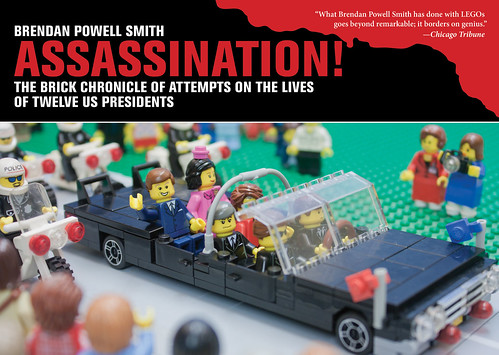
For many years now I've beein reviewing Brendan Powell Smith's work, and up till now it has all been about his LEGO take on biblical material. When I heard his newest book was on a different topic altogether, I have to admit I was disappointed. For some time now I've been hoping he would do a version of the Psalms and the Prophets - I think those texts would provide a great opportunity for imaginitive LEGO interpretations. I have to say, though, that I was very pleasantly surprised. Assassination! is, in a word, terrific. This 272 page hardcover book is filled with over 400 LEGO illustrations, detailing the history of US president assassinations and assassination attempts.
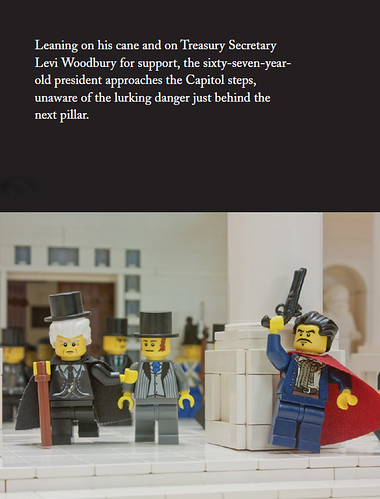
The illustrations are top-notch. Back in the early days of Brendan's Brick Testament project his landscapes were often flat and the photos fairly sparse, but a decade of LEGO illustration has changed all of that. The images are all 100% LEGO from edge to edge, and they are richly detailed. He has taken full advantage of the wide range of LEGO elements that have come out in recent years, as well as custom accessories by third party AFOL dealers (SaberScorpion's custom decals of the presidents' faces are particularly good). Brendan's building has steadily progressed over the years, and he has a keen eye for composing scenes.
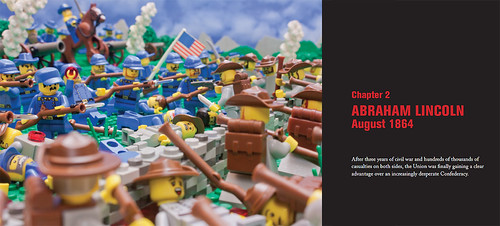
But, unlike some LEGO books, this isn't just about the pictures. The text is also really good. Brendan covers the four presidential assassinations and a great number of the attempts that have happened over the past two hundred years of US history. He takes great delight into going into some of the quirky facts around these cases, often delving into the odd backstories of the perpetrators. I felt that I knew a fair amount about some of these - Licoln, due to his importance to US history, Kennedy, because you can hardly turn on the History channel without some new documentary on him, and the attempt on Reagan's life, because I remember it quite well - but I still learned quite a lot on these, not to mention some of the less prominent attempts that I didn't know anything about. I was fascinated, and sat and read it cover to cover in about three hours, pausing to pore over the pictures.
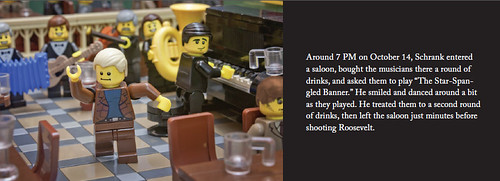
I can't recommend this book highly enough. I still have several LEGO books to read through from this recent set of offerings, but I am fairly certain that the combination of great images and compelling text will make this my favorite LEGO book of 2013. Certainly all US AFOLs should get this, but I think that even non-Americans with an interest in history would find this quite enjoyable.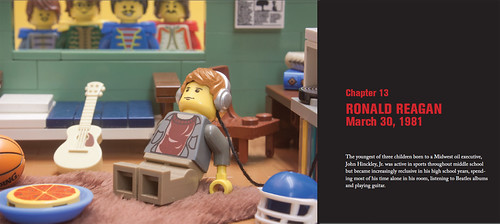
Blog-specific content - While Brendan's work is almost always directly relevant to this blog, this book is not, mostly. One thing I did note is that he is often quick to point out odd religious motivations of the people involved. While this is usually on point, since some of the assassins were acting on what they felt were instructions from God, in a couple of places it felt like it was kind of shoe-horned in based on Brendan's own attitudes towards religious faith.
Please note that I'm posting this same review across all my blogs, but I'm appending some blog-specific information at the end of each one.

For many years now I've beein reviewing Brendan Powell Smith's work, and up till now it has all been about his LEGO take on biblical material. When I heard his newest book was on a different topic altogether, I have to admit I was disappointed. For some time now I've been hoping he would do a version of the Psalms and the Prophets - I think those texts would provide a great opportunity for imaginitive LEGO interpretations. I have to say, though, that I was very pleasantly surprised. Assassination! is, in a word, terrific. This 272 page hardcover book is filled with over 400 LEGO illustrations, detailing the history of US president assassinations and assassination attempts.

The illustrations are top-notch. Back in the early days of Brendan's Brick Testament project his landscapes were often flat and the photos fairly sparse, but a decade of LEGO illustration has changed all of that. The images are all 100% LEGO from edge to edge, and they are richly detailed. He has taken full advantage of the wide range of LEGO elements that have come out in recent years, as well as custom accessories by third party AFOL dealers (SaberScorpion's custom decals of the presidents' faces are particularly good). Brendan's building has steadily progressed over the years, and he has a keen eye for composing scenes.

But, unlike some LEGO books, this isn't just about the pictures. The text is also really good. Brendan covers the four presidential assassinations and a great number of the attempts that have happened over the past two hundred years of US history. He takes great delight into going into some of the quirky facts around these cases, often delving into the odd backstories of the perpetrators. I felt that I knew a fair amount about some of these - Licoln, due to his importance to US history, Kennedy, because you can hardly turn on the History channel without some new documentary on him, and the attempt on Reagan's life, because I remember it quite well - but I still learned quite a lot on these, not to mention some of the less prominent attempts that I didn't know anything about. I was fascinated, and sat and read it cover to cover in about three hours, pausing to pore over the pictures.

I can't recommend this book highly enough. I still have several LEGO books to read through from this recent set of offerings, but I am fairly certain that the combination of great images and compelling text will make this my favorite LEGO book of 2013. Certainly all US AFOLs should get this, but I think that even non-Americans with an interest in history would find this quite enjoyable.

Blog-specific content - While Brendan's work is almost always directly relevant to this blog, this book is not, mostly. One thing I did note is that he is often quick to point out odd religious motivations of the people involved. While this is usually on point, since some of the assassins were acting on what they felt were instructions from God, in a couple of places it felt like it was kind of shoe-horned in based on Brendan's own attitudes towards religious faith.
Thursday, November 28, 2013
Happy Thanksgiving
"No human counsel hath devised nor hath any mortal hand worked out these great things. They are the gracious gifts of the Most High God, who, while dealing with us in anger for our sins, hath nevertheless remembered mercy. It has seemed to me fit and proper that they should be solemnly, reverently and gratefully acknowledged as with one heart and one voice by the whole American People. I do therefore invite my fellow citizens in every part of the United States, and also those who are at sea and those who are sojourning in foreign lands, to set apart and observe the last Thursday of November next, as a day of Thanksgiving and Praise to our beneficent Father who dwelleth in the Heavens. And I recommend to them that while offering up the ascriptions justly due to Him for such singular deliverances and blessings, they do also, with humble penitence for our national perverseness and disobedience, commend to His tender care all those who have become widows, orphans, mourners or sufferers in the lamentable civil strife in which we are unavoidably engaged, and fervently implore the interposition of the Almighty Hand to heal the wounds of the nation and to restore it as soon as may be consistent with the Divine purposes to the full enjoyment of peace, harmony, tranquillity and Union." - Abraham Lincoln, 1863


Wednesday, November 27, 2013
Happy Thanksgivukkah
Hanukkah comes early this year. For the first time in over a century, and the last time for over 79000 years, the first full day of Hanukkah comes at the same time as Thanksgiving. The Hebrew calendar is lunisolar, that is, it is based both on the solar year and on the lunar phases, so it varies on a 19 year cycle. Many are having fun with this rare coincidence of holidays, for instance creating 'Menurkeys' (Menorah/turkey mashups). Here is Dave Kaleta's version. I hope all of my Jewish readers have a very blessed holiday.


Fuente de los Leones
BrickSur was an exhibition by LEGO builders in Granada, Spain, earlier this month. Attendees were able to purchase a commemorative kit of the Fuente de los Leones, or Fount of the Lions, a Granada landmark. This fountain can be found in the palace of Muhammed V, built during the Nasrid dynasty, when Arab Muslims ruled the southern portion of modern day Spain. The courtyard of the palace is symbolically patterned after a Muslim view of paradise, with the four portions of the world watered by four rivers, flowing from the fountain. The fountain itself is an earlier work, perhaps from the home of an important Jewish official, and the twelve lions represent the twelve tribes of Israel.




Saturday, November 23, 2013
LEGO Adventure Book, Volume 2
LEGO Adventure Book, Volume 2 by Megan Rothrock, 2013, No Starch Press
Please note that I'm posting this same review across my blogs, but I'm appending some blog-specific information at the end of each review.
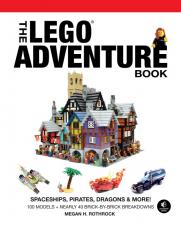
'Tis the season for new LEGO books. I've got a stack of new LEGO books to review, so over the next couple of weeks I'll be posting these reviews every couple of days. Last year, Megan Rothrock's LEGO Adventure book was among those that received my highest praise, and I'm so happy that she has continued her series with a second volume (and the book ends with "The adventure continues...", so we're promised at least a third volume, presumably this time next year). This book is very much in the same style as last year's volume. Meg's sig-fig travels around, meeting AFOLs from around the world, and along the way we get to see their great builds and get instructions and tips as to how to build our own versions.
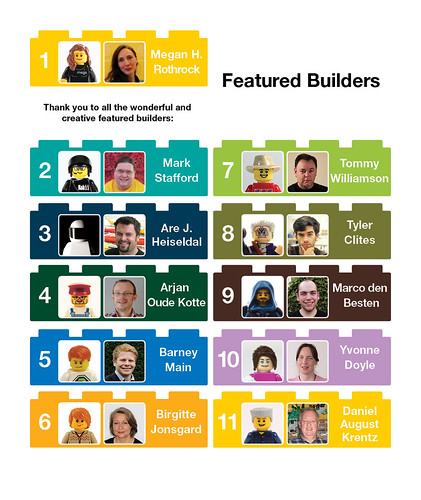
Once again, Meg has assembled a great line-up of builders - three repeats from last year, and seven newcomers. Specifically she includes builds by herself, Mark Stafford, Are Heiseldal, Arjan Oude Kotte, Barney Main, Birgitte Jonsgard, Tommy Williamson, Tyler Clites, Marco den Besten, Yvonne Doyle, and retired LEGO designer (and the guy who designed the Yellow Castle!) Daniel August Krentz. Building styles include space, pirate, town, Friends, micro, post-apoc, among others.
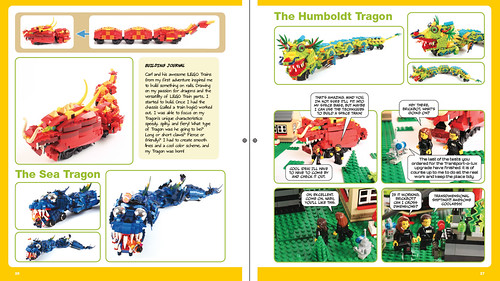
I did see some differences between volume 1 and volume 2. It seems that the building directions are more detailed in this volume, which is nice. All of the builds have lists of what bricks you will need, which were missing from some of the directions in volume 1. There are fewer builders for the same number of pages, and I think this can be explained by the greater number of pages devoted to detailed building instructions, and also more additional models for those builders who were included. Also, this book has more of a story than volume 1. In the previous book Meg was simply visiting other builders. Here she is chasing the "Destructor" through these different LEGO lands. Whereever he goes, the Destructor destroys MOCs. This, then, gives Meg's sig fig the opportunity to help rebuild them. It's a nice device that then gives the excuse to include building instructions as part of the narrative. One suggestion would be to have shown the original MOCs before the Destructor came along, and then show the rebuilding. Since in a couple of places they note that the rebuild was not exactly the same as the original, this might be a good way to show that you can use LEGO to build in different ways. I liked that there was some inclusion of microscale, though the one model was still in a fig-scale world as a movie prop.

As I noted in my review of volume 1, this series is a celebration of the AFOL community. There are some nice inclusions that you pick up on if you know the community references or the people involved. For instance, Meg and Mark come across as partners in the book, reflecting their real-life relationship. Meg also includes a MOC of their dog, Bandit, who passed away this year (probably after the book went to print, now that I think of it). Tommy's MOCs are based around a movie set, reflecting his real-life profession. We get a reference to the Guilds of Historica project on Eurobricks. I was wondering if the reference to the CCC, the Council of Creative Constructionists, was a veiled reference to the Colossal Castle Contest or just a coincidence of acronyms. Other nods include the inclusion of post-apoc as a fan theme, a reference to online contests, and a micro rendition of the fan-favorite Galaxy Explorer. The community reference that most warmed my heart, though, was the inclusion of Vic Vipers. I know that Mark has previously worked a reference to the late Nnenn into an official set, and it was great to see these included, particularly in a book that came out during Novvember. I love these little peeks into the AFOL community, which are still subtle enough that people from outside the community can equally enjoy the book without feeling somehow out of the loop.

As with volume 1, I would give my highest recommendation for LEGO Adventure Book, Volume 2. The audience could range from a kid on up to a long-time AFOL; model difficulties range from intermediate to challenging; the variety of themes will have something for everyone. I'm very much looking forward to volume 3. One suggestion, if Meg happens to read this, is that in future volumes we should see Western and Ancient, two building areas that haven't been covered yet, and also some more exploration of scale, such as additional micro building and also things like miniland scale. I'd also love to see some licensed themes (Star Wars, DC, Marvel, Tolkien), but I completely understand how that might run into additional IP headaches when producing a book like this.
Blog-specific content: There is none.
Please note that I'm posting this same review across my blogs, but I'm appending some blog-specific information at the end of each review.

'Tis the season for new LEGO books. I've got a stack of new LEGO books to review, so over the next couple of weeks I'll be posting these reviews every couple of days. Last year, Megan Rothrock's LEGO Adventure book was among those that received my highest praise, and I'm so happy that she has continued her series with a second volume (and the book ends with "The adventure continues...", so we're promised at least a third volume, presumably this time next year). This book is very much in the same style as last year's volume. Meg's sig-fig travels around, meeting AFOLs from around the world, and along the way we get to see their great builds and get instructions and tips as to how to build our own versions.

Once again, Meg has assembled a great line-up of builders - three repeats from last year, and seven newcomers. Specifically she includes builds by herself, Mark Stafford, Are Heiseldal, Arjan Oude Kotte, Barney Main, Birgitte Jonsgard, Tommy Williamson, Tyler Clites, Marco den Besten, Yvonne Doyle, and retired LEGO designer (and the guy who designed the Yellow Castle!) Daniel August Krentz. Building styles include space, pirate, town, Friends, micro, post-apoc, among others.

I did see some differences between volume 1 and volume 2. It seems that the building directions are more detailed in this volume, which is nice. All of the builds have lists of what bricks you will need, which were missing from some of the directions in volume 1. There are fewer builders for the same number of pages, and I think this can be explained by the greater number of pages devoted to detailed building instructions, and also more additional models for those builders who were included. Also, this book has more of a story than volume 1. In the previous book Meg was simply visiting other builders. Here she is chasing the "Destructor" through these different LEGO lands. Whereever he goes, the Destructor destroys MOCs. This, then, gives Meg's sig fig the opportunity to help rebuild them. It's a nice device that then gives the excuse to include building instructions as part of the narrative. One suggestion would be to have shown the original MOCs before the Destructor came along, and then show the rebuilding. Since in a couple of places they note that the rebuild was not exactly the same as the original, this might be a good way to show that you can use LEGO to build in different ways. I liked that there was some inclusion of microscale, though the one model was still in a fig-scale world as a movie prop.

As I noted in my review of volume 1, this series is a celebration of the AFOL community. There are some nice inclusions that you pick up on if you know the community references or the people involved. For instance, Meg and Mark come across as partners in the book, reflecting their real-life relationship. Meg also includes a MOC of their dog, Bandit, who passed away this year (probably after the book went to print, now that I think of it). Tommy's MOCs are based around a movie set, reflecting his real-life profession. We get a reference to the Guilds of Historica project on Eurobricks. I was wondering if the reference to the CCC, the Council of Creative Constructionists, was a veiled reference to the Colossal Castle Contest or just a coincidence of acronyms. Other nods include the inclusion of post-apoc as a fan theme, a reference to online contests, and a micro rendition of the fan-favorite Galaxy Explorer. The community reference that most warmed my heart, though, was the inclusion of Vic Vipers. I know that Mark has previously worked a reference to the late Nnenn into an official set, and it was great to see these included, particularly in a book that came out during Novvember. I love these little peeks into the AFOL community, which are still subtle enough that people from outside the community can equally enjoy the book without feeling somehow out of the loop.

As with volume 1, I would give my highest recommendation for LEGO Adventure Book, Volume 2. The audience could range from a kid on up to a long-time AFOL; model difficulties range from intermediate to challenging; the variety of themes will have something for everyone. I'm very much looking forward to volume 3. One suggestion, if Meg happens to read this, is that in future volumes we should see Western and Ancient, two building areas that haven't been covered yet, and also some more exploration of scale, such as additional micro building and also things like miniland scale. I'd also love to see some licensed themes (Star Wars, DC, Marvel, Tolkien), but I completely understand how that might run into additional IP headaches when producing a book like this.
Blog-specific content: There is none.
Friday, November 22, 2013
C.S. Lewis
While all the news outlets are remembering the assassination of John F Kennedy fifty years ago today, we should not forget another great man that died on the same day - C.S. Lewis.* The author is known for his many works, ranging from professional writing about literature, to philosophical defenses for the Christian faith, to his rich fictional worlds. He will probably always be most associated with the magical world of Narnia, where several English children got to know Jesus, as he was incarnated in that world as a lion named Aslan. Here Allen reproduced Peter's shield, bearing the emblem of Aslan. As Lewis described it in The Lion, the Witch and the Wardrobe, "The shield was the colour of silver and across it there ramped a red lion, as bright as a ripe strawberry at the moment when you pick it."
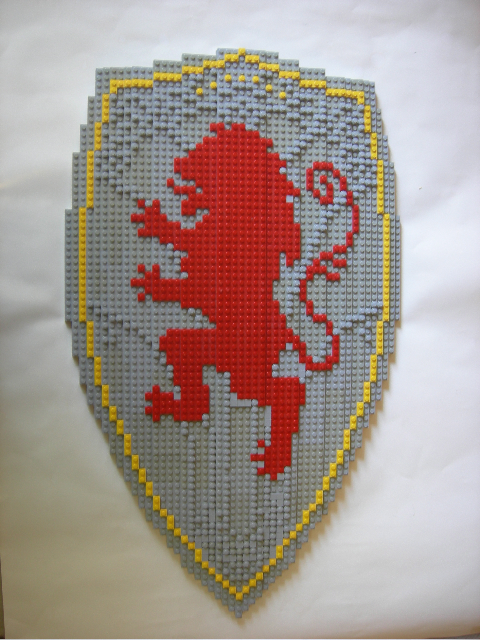
*I should also note that Aldous Huxley died on the same day as well. Christian philosopher and Lewis scholar Peter Kreeft wrote a book, Between Heaven and Hell, in which he imagines Kennedy, Lewis and Huxley meeting in a sort of limbo after their deaths and debating their various world views.

*I should also note that Aldous Huxley died on the same day as well. Christian philosopher and Lewis scholar Peter Kreeft wrote a book, Between Heaven and Hell, in which he imagines Kennedy, Lewis and Huxley meeting in a sort of limbo after their deaths and debating their various world views.
Subscribe to:
Comments (Atom)
